
A Step-by-step guide to creating and implementing a Keyword Strategy with Serpstat
A keyword strategy is one of the crucial success factors for website promotion. Being developed poorly, it may hurt your rankings, while a proper researched strategy will bring your site to the top of search results.
That’s why keyword research is among the first tasks for SEOs and website owners. But you won’t get far without a quality tool. Serpstat is an all-in-one SEO platform providing users with all the necessary data for building a solid SEO strategy. Serpstat has collected keyword and competitors analysis data for all the countries in the world, covering now 230 Google databases.
Serpstat tools will help you collect the best keywords and provide you with actionable tips for distributing these keywords within your website. In this post, you’ll learn how to use Serpstat to conduct in-depth keyword research.
Reminder: Serpstat is changing Pricing Plans from June 10. Participate in the Last Chance Sale to buy your plan for old price and fix the limits for the duration of your subscription.
The right method of keyword research for your site depends on several factors. If you’ve already been running a website and want to find keyword gaps, website or competitor analysis is the best decision. If you start from scratch without any idea on what your niche looks like, you’d better go with conventional keyword research.
I’ll cover two methods of finding the right keywords.
* Both methods are accessible with Serpstat API – a set of methods that allows integrating Serpstat analytics into your custom interface tools.
Method 1: Conventional Keyword Research
The first method is to go with Serpstat Keyword Research tool. All you should do is to enter your target keyword, select your country, and click on Search.

You’ll see the Overview dashboard with all the metrics of the queried keyword. There are two scores you should pay particular attention to: Search Volume and Keyword Difficulty. The first score shows how many searches in Google drives your analyzed keyword every month. The second one predicts how difficult it will be for a new page to rank for this keyword. So, if you are a newbie, you’d better focus on the low-to-middle keyword difficulty level.
Let’s move on and explore how to select the best keywords for your goals.
Step 1: Get the list of generic keywords
Click through the SEO Research > Keyword Selection section, and you’ll find all keywords from Serpstat database that contain the keyword you’ve entered into the search box.

Every keyword is provided with the following metrics:
- Keyword Difficulty;
- Volume Google;
- CPC;
- Competition in PPC;
- Results;
- Social domains.
You can also find a column that lists special elements in SERP showing up for each keyword. If you want to collect keywords to optimize for some particular special element, you should apply a specific Filter. In the next step, I’ll tell you how to do that.
Step 2: Filter your keyword list
The Keyword Selection report provided me with 2.3K keywords associated with the ‘keyword research’ query. Do I need all of them? Of course, I don’t. To collect only relevant keywords and not to sort them manually, I’ll apply Filters.
The search queries can be sorted by up to ten criteria:
- CPC;
- Number of results;
- Competition level;
- Number of words in a keyword;
- Special elements in SERP;
- Toponyms;
- Misspelled keywords;
- Keywords;
- Keyword difficulty.
Filter the keywords by one or several criteria at once, and you’ll get the list of search queries which are the best for you.
For instance, I applied two filters:
- Special elements in SERP > Includes > Featured snippets to collect keywords I should optimize for to get the chance to win a featured snippet.
- Keywords difficulty > Between > 10 and 60 not to waste my time trying to reach the top for the queries with a too high keyword difficulty level.
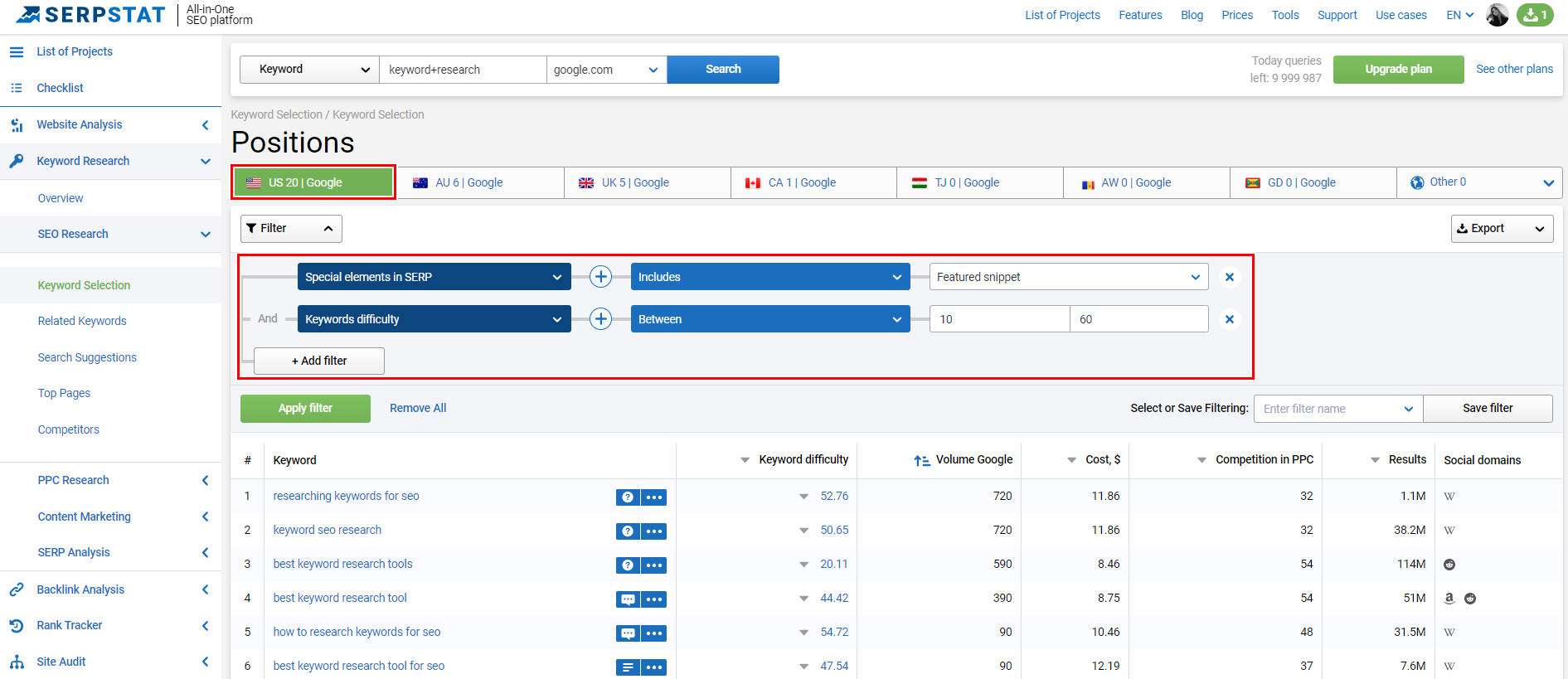
You can see there are only 20 keywords left – a reasonable number to work with.
Step 3: Collect long-tail keywords
Long-tail keywords are incredibly popular these days and for a good reason. Although having relatively low search volume, these three and more keyword queries will drive you the most targeted traffic. As long-tail keywords are very specific, people typing them usually know already what they want.
That’s why collecting long-tail keywords should be the second step after you got the list of generic keywords.
For this purpose, go to the Search Suggestions report. Here you’ll see all search suggestions (popular search queries that pop up under the search bar as you start typing your seed keyword on Google) related to the researched keyword.
This report lets you not only collect long-tail keywords but also get the list of question-based queries only. Using questions in your subheads, you increase your chances of getting featured and ranking for voice search queries. So click on Only questions to collect only question-based keywords.

Not to export all the questions, you can filter the results by the specific words (1) or export only individual groups of questions containing particular questions words (2).
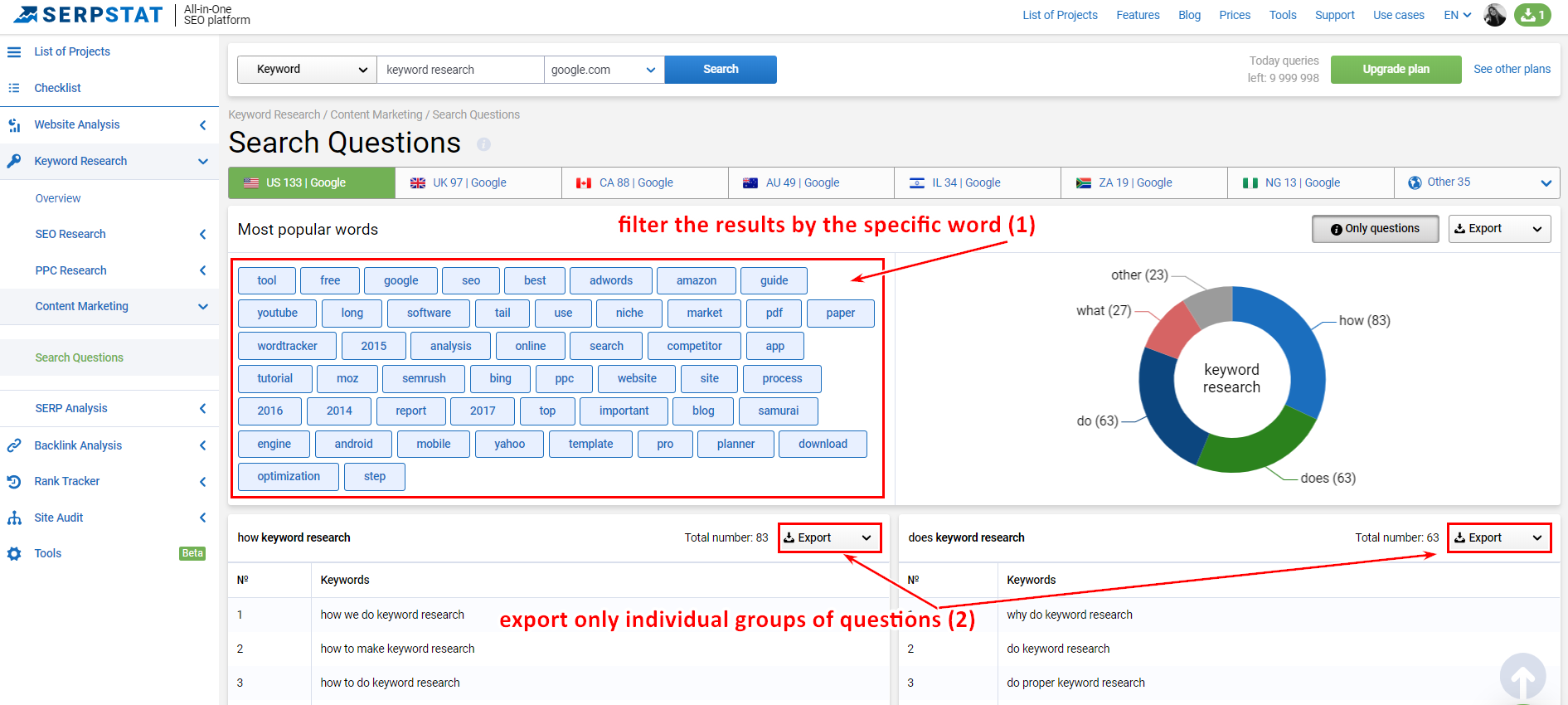
Step 4: Collect LSI keywords
You don’t want to get Google penalty for keyword stuffing, so it’s time to collect related keywords.
Serpstat Related Keywords report shows all search terms and phrases semantically connected to the queried keyword sharing identical pages in search results. Here you can filter the results by up to six criteria.

Method 2: Competitor analysis
This keyword research strategy implies your competitor’s domain or URL analysis aimed at collecting their keywords. This method could be subdivided into two separate approaches:
Let’s look into each approach.
Domain analysis
If you already know your closest search competitor, enter their domain into the search bar, select your country, and click on Search. If not, start with Keyword Research: enter your target keyword, and scroll down to the Competitors in organic search report.
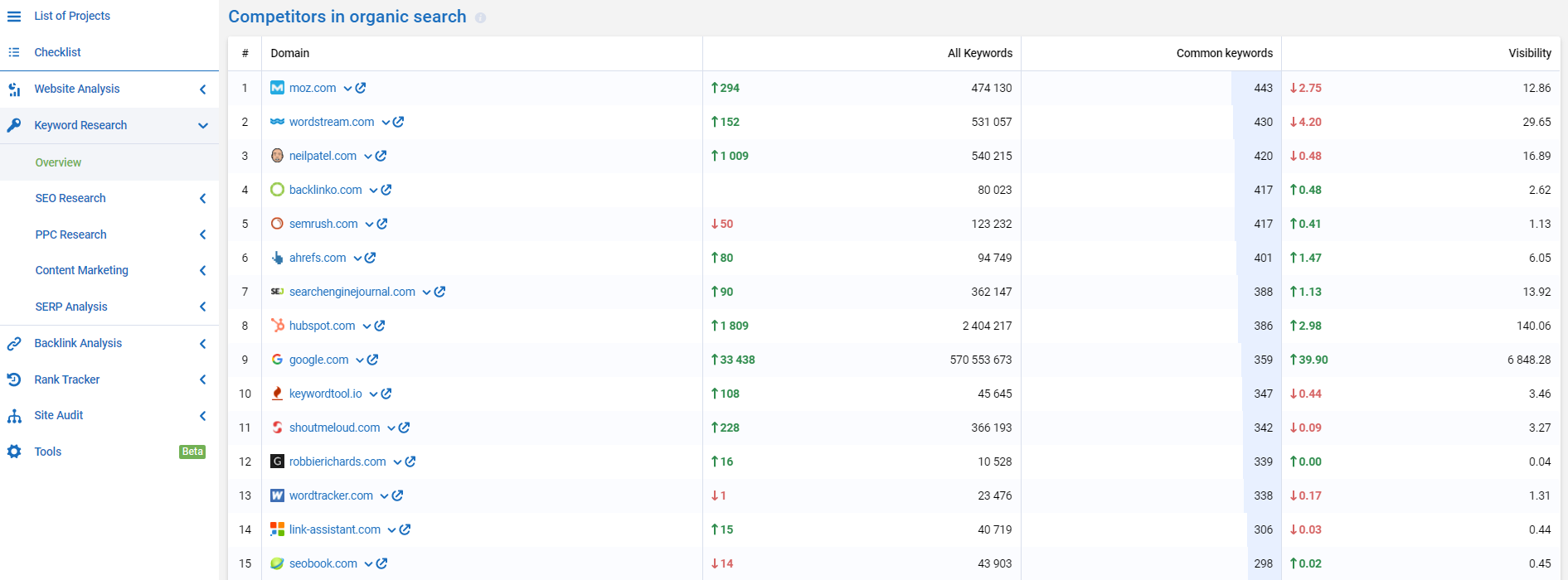
Select one competitor and click through the chosen domain. You’ll find the report similar to the Keyword Selection report, with the only difference: the list consists of the keywords your competitor is already ranking for. That’s why I recommend you to exclude branded keywords applying the Keywords filter.

To narrow the list, you can also apply the same filters I described in the first step of the conventional keyword research method.
In case you can’t exclude all the branded phrases manually, the Domain vs Domain section will help you cope with it. Select two other competitors from the list and click on Compare.

The report provides a side-by-side comparison of three domains, showing their organic and paid keywords.
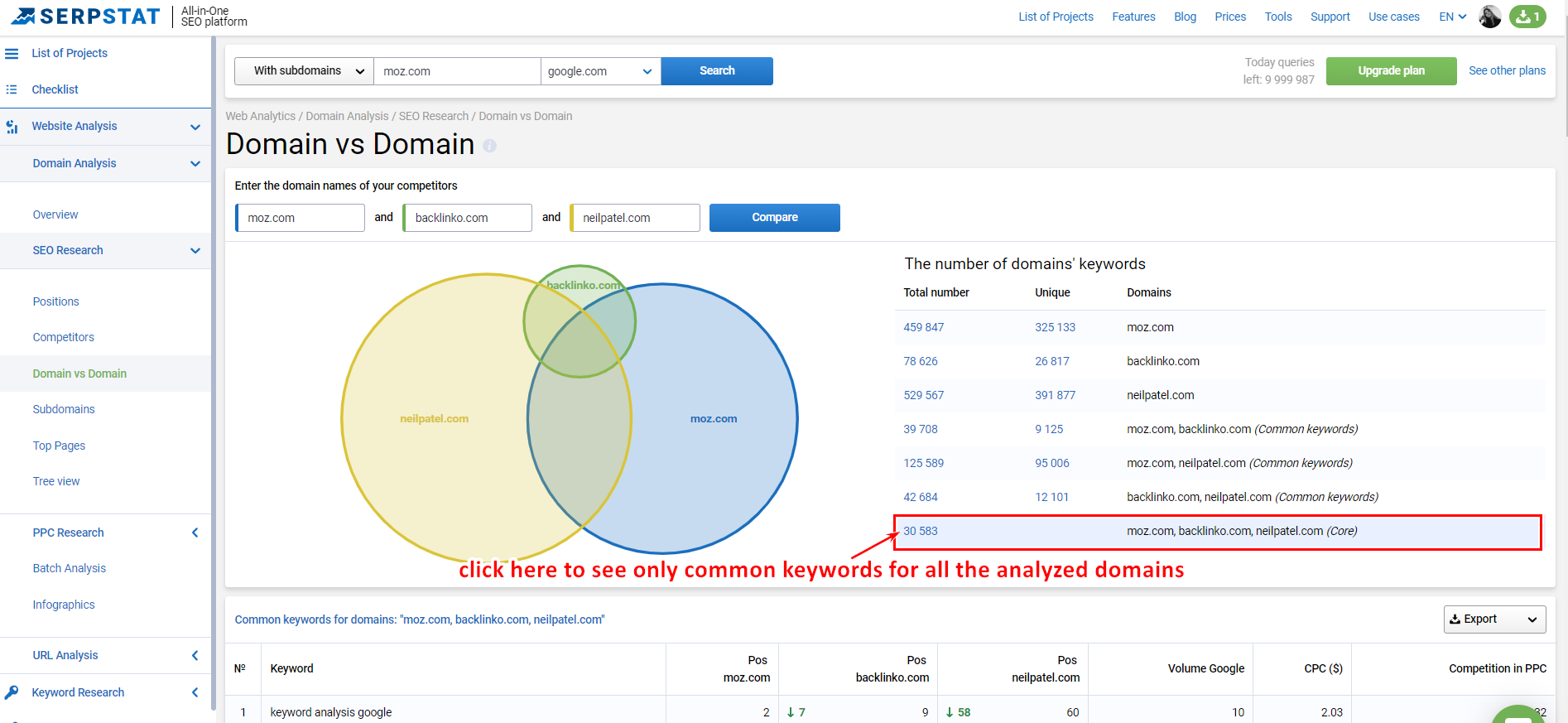
Clicking on the number of common keywords for three compared domains, you’ll see the list of all these keywords below. As each of the selected competitors’ is ranking for these keywords on Google, you’ll know for sure there are no branded keywords in the list.
* This method is also handy for identifying keyword gaps on your site. Compare your and your competitors’ domains to find keywords their two domains are ranking for, but yours isn’t.
URL analysis
This approach is convenient if you want to collect keywords for the specific web page. The pattern is pretty easy: when you enter your target keyword, go to the Top Pages section. You’ll find the list of pages ranking for at least one keyword associated with the queried one. The pages are sorted by the number of keywords they are ranking for in the top 20 search results.

Click through one of the pages, and you’ll see all the keywords it’s ranking for.

Bonus: Find keyword gaps for the specific pages
With the unique Missing Keywords feature, you can identify the keywords your competitors are ranking for in top 10 search results, but the analyzed page isn’t showing up for even in top 100 Google results.
You only need to enter the URL of the page you want to optimize and go to the Missing Keywords report.

The final touch: Split the keywords into groups and incorporate them into separate pages
When the right keywords are researched and exported, it’s time to implement them. If you went with conventional keyword research or domain analysis, you probably have a bunch of various keywords. To incorporate these keywords into separate pages, you should start with splitting the list into groups.
Of course, having the list of fifty keywords, you can do it manually. But what if there are hundreds or thousands of search queries? To ease this process, Serpstat team developed a tool for automatic keyword mapping. This Keyword Clustering tool will analyze the keywords and group them based on their semantic similarity.
To start clustering, go to the Tools section, and click on Create project. Then, enter the project name, download the list of keywords, and configure settings. The last setting tab offers you to select the Linkage Strength and the Type of Clustering. Shortly, the more specific clusters you want to get, the stronger should be these two parameters.
When the report is ready, you’ll see all your keywords grouped into separate clusters. If needed, you can edit, remove or add clusters.

Now all your potential keywords are grouped, and you can optimize your pages for the specific keyword clusters.
The last step is analyzing every individual cluster to get the tips to how to distribute these keywords within the page. Serpstat Text Analytics will provide you with a set of words to be used in specific areas of the page (Title, H1 and Body sections). If you click on Start TA, after a while, you’ll get an in-depth report based on the analysis of text content of the best-performing pages for the cluster search queries.

* If you have a page you are targeting these keywords with, you can analyze it adding its URL to the cluster. The tool will analyze its texts and show you how relevant these keywords are to the page content.
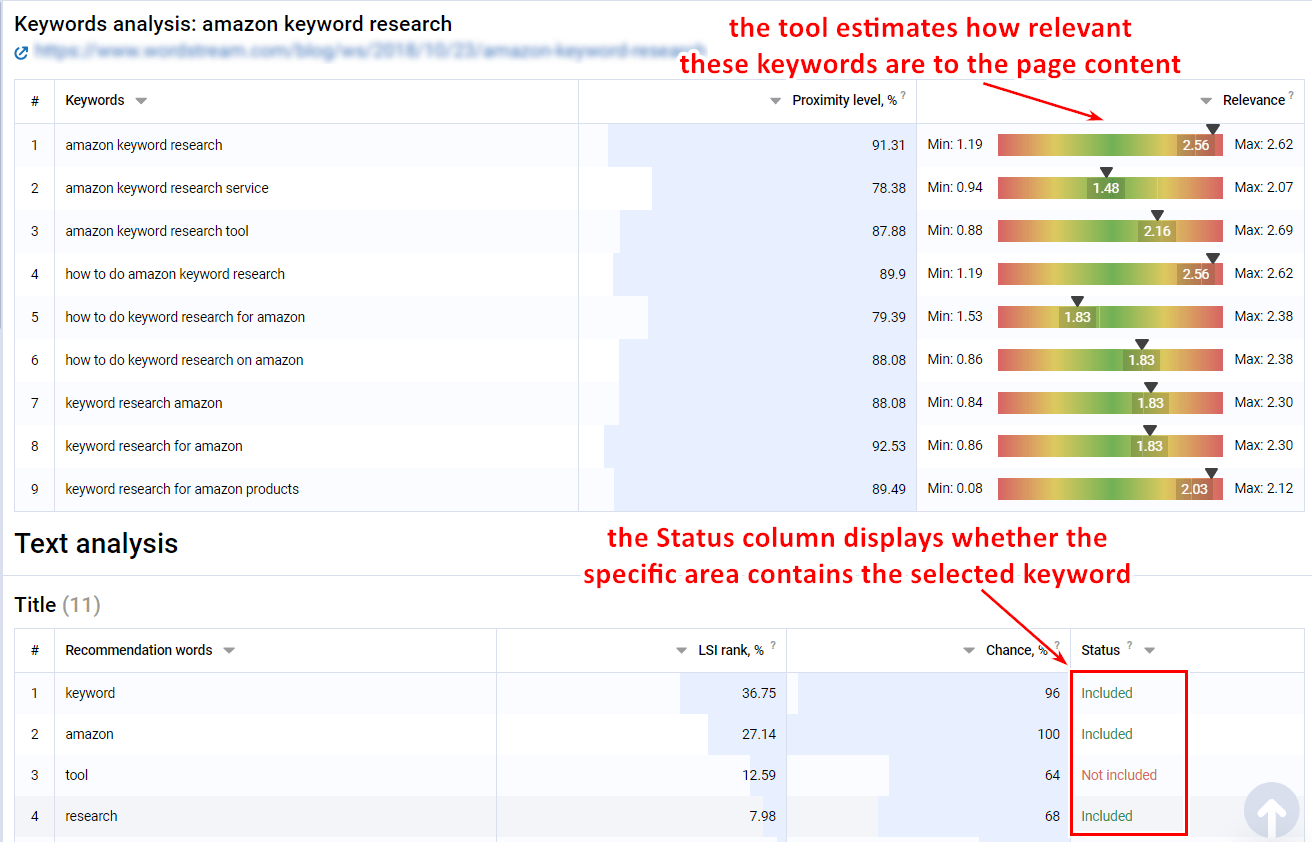
Conclusion
Ranking for the right keywords is key to great traffic and a highly relevant audience. But keyword research is only the beginning of a long journey. To build a successful strategy, you should be tracking your results and testing new techniques constantly.
About the author

Adelina Karpenkova
is a Brand Specialist at Serpstat, an all-in-one SEO platform. She loves providing actionable tips to help readers improve their marketing and SEO strategies. She thinks content marketing is the best mechanism to claim your expertise and build your brand. Connect with her on LinkedIn or Twitter.












 Get the new Chrome Extension!
Get the new Chrome Extension!